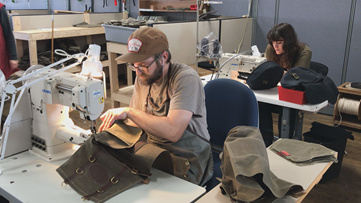Be that as it may, because of the general load of the calfskin surface facilitating the pressure-touchy sensors, a slight pressing factor was applied constantly to them. Even though the choice to cut a major calfskin surface, rather than cutting separate cowhide surfaces for every single one of the ‘pushbuttons’ was taken for reasons identified with development and visual properties, a similar outcome would not have occurred if different materials had been utilized, for example, neoprene or thick texture. People at leather making workshop singapore have more knowledge to make leather products. The brisk answer for this issue was to add a supple plastic material with openings between the different sides of every sensor, to dispose of the affectability of every sensor region, brought about by the applied weight of the cowhide surface. Even though a more pressing factor was required a while later for setting off the sound, generally speaking, the intelligent interface was more powerful and receptive to cooperation.
In any case, an powerful interface isn’t in every case enough with regards to communication.

Since the interface and collaboration were so basic, the thought was to let guests at the show investigate and find on their own how to utilize and play with the soundbox. Notwithstanding, during the five days of the presentation, we noticed how guests rather than promptly regarding the interface as ‘pushbuttons’, frequently got going by delicately contacting and stroking the surface. A piece of this could be because of the uncertain plan of the interface, yet it additionally appeared as the material as such welcomed this sort of control, maybe because of an anomaly of contacting the cowhide, to feel its surface and quality. The outcome was that it got more earnestly than we had envisioned for guests to find the intuitive characteristics of the soundbox and how to start the connection. The principal issue was that in this particular plan the pressing factor sensors under the cowhide surface were set off by applying power, instead of touch. In a later investigation, we supplanted the material pressing factor sensors with capacitive sensors under wooden or calfskin surfaces, set off by slight touch, rather than pressure. This ends up being significantly more fruitful regarding cooperation and more ‘characteristic’, as far as the intelligent affordances of these particular materials.
During these investigations, we utilized the open-source laser shaper
This all collected and worked in our workshop space. One clear angle that made this cycle distinctive contrasted with handcrafting was that a few pieces of the cycle, which were recently done by hand and utilizing hand devices, were currently performed utilizing a laser shaper. In particular, the sketch was drawn on a PC utilizing 3D displaying programming, which is viable with the laser shaper model. We would say, this ‘automatized’ creation measure saved a lot of time contrasted with handcrafting the calfskin antiquity and drawing pieces physically on paper. Nonetheless, it requested additional time to be spent on the beginning phases of reasoning and planning how the last calfskin thing should look and capacity, previously sending the 2D drawing for cutting. A reflection to this perception is that making in this setting can be viewed as the nitty-gritty and smart sketch on the modeling software, while generally making alluded to the control of material exclusively by hand.

